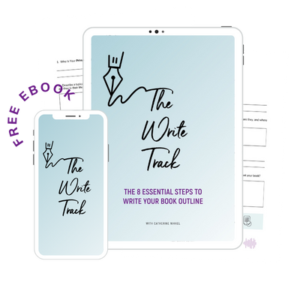Have you ever felt like you don’t know where you begin when writing something? Wondering the right or wrong way of the writing process steps?
Or you started a piece, but it ended up taking a permanent position in your drafts folder.
Without a vision and a process, writing can sometimes feel overwhelming.
That’s why it’s helpful to have a proven step-by-step writing process that you can return to time and time again to complete the social media caption, blog post, or book you are writing.
In this article, I will outline the six key steps with writing process steps that will support you regardless of you’re writing.
Naturally, depending on the complexity and length of the piece, the time you spend on each step in the writing process will vary. However, they are all necessary and crucial steps to ensure your work is complete and enjoyable for your readers.
Let’s dive in. I know you’re getting anxious to start writing – and don’t worry, we’re going to get you there!
Step 1: Pre-writing
Create Your Vision
As you begin your own writing project, you first need to create your vision; establish the main idea you will write about.
If you haven’t already, you will need to reflect on a few key questions during the pre-writing stage:
What is the purpose of my writing?
What message do I want to share?
Who is my intended audience?
How do I want to impact them?
It can be helpful to develop a thesis statement for your work, which I like to call the “North Star.”
This helps anchor your writing and captures the general idea of what you want to share in one sentence.
Consider this is the elevator pitch of your writing piece.
The “North Star” template I typically share with my clients is:
I will use my book/caption/post to target {introduce your primary audience} by teaching them {your purpose/idea}, which will lead to my ultimate goal of more {insert objectives}
Brainstorming
From here, you can start to brainstorm ideas.
Write anything and everything that comes to mind for you.
Don’t worry about writing in too much detail at this point; using bullet points to express your ideas is perfectly acceptable.
Create a mind map (a visual representation of your brainstorming showing the connection between different words and ideas).
Research
Depending on what you are writing, do some research.
Confirm facts if you share information, find reliable resources, and check what your competitors do.
Conducting research may also include reading and analyzing pieces of work that inspire you to try and understand what you enjoy about a specific author or style of writing.
Good writing always begins with reading!
Continue Improving Your Writing Skills
Being a good writer can take some time, so if you want to improve your writing skills, look at this article I wrote with some tips to support you in becoming a better writer.
My advice – take every opportunity to pre-write.
Especially when you have yet to set a deadline or have a specific piece in mind.
We often get our best ideas spontaneously.
This is where a little black book (or digital notepad) of ideas can come in handy. Anytime you feel inspired or have a spur-of-the-moment idea, write it down.
Step 2: Planning/Outlining
Now that you have your many ideas written down, it’s time to start organizing them.
The planning stage involves reading and laying out all your information and determining what will be included in this writing.
For a social media post or blog, you may pick one topic or even use your ideas to create a content bank, sorting your ideas into content pillars for future use.
If you are writing a book, you must organize your ideas into an outline.
An outline will help you stay organized and ensure a smooth transition to the next phase in the writing process.
This is where you will need to establish the scope of your book (e.g., a theme or a specific time in your life) and determine what will be included and (equally important) what will not be included.
You will also need to consider the flow of your ideas and how you can write in a way that will keep your readers engaged.
I have an excellent article for more information and expert tips on How to Write a Book Outline.
Step 3: Drafting (The First Draft)
With your roadmap (or content bank), it’s time to start writing your first draft.
As you begin the drafting process, write freely without worrying too much about grammar, sentence structure, or word count.
Focus on getting your main ideas down and, more importantly, letting your creativity flow.
You will have a chance to perfect the flow of ideas, and chapter transitions later!
If you are writing a book, start with any chapter or section that calls to you.
Remember, this is a first draft, also known as a rough draft.
Take your time with it and set realistic goals and expectations for when you want to finish this step.
Once you have finished your first draft, step back and celebrate!
This is a huge accomplishment.
As much as you might be eager to move to the next and final step of revising and re-writing, you will benefit significantly from taking a step back.
Do something fun unrelated to your book or writing piece.
Allow yourself to be inspired and refreshed to approach the next step with fresh eyes.
…and then, you can begin the revising stage.
Step 4: Revising (The Second Draft)
It’s time to review your first draft.
During the revising and editing process stage, you will want to review your writing with a critical eye.
It can help to experience your writing differently (e.g., read your work aloud, print a paper copy, and mark it up).
As you review:
Highlight parts of your work that you would like to improve.
- During this phase, I like to include lots of little notes that I can use to improve my work (e.g., check this resource, elaborate further on this idea, use more descriptive language)
Consider combining sections (where it makes sense)
Remove items that may not fit with the overall flow.
Check for inconsistencies and redundant content.
The goal most writers have at this stage in the process is to focus on the big picture and make sure they have included all the necessary details in their written piece.
Note: If you are an experienced writer or working on a short piece (such as social media content), you may be able to skip this last step.
Step 5: Editing and Proofreading
You now have a somewhat final draft in hand.
The editing stage and the proofreading stage is where most writers get into the details when it comes to reviewing. The time you devote to this stage will depend on the length and complexity of your writing piece.
I generally like to divide this stage into two parts (especially for longer, more complex pieces):
Part 1: General Editing and Review
This involves reviewing the final draft for sentence structure and clarity.
You will want to improve the readability and ensure a consistent tone is used throughout.
Part 2: Proofreading
Next, you will fine-tune your work more carefully – checking for any grammatical errors, mistakes, and spelling errors.
During this phase, you will significantly benefit from using the spell-check feature on your word-processing tool plus a grammar-checking tool such as Grammarly [Read: Why we Love Grammarly] to support you.
Important Note about your Writing Process Steps:
If you write a book, get a third party to edit and proofread your work.
Family and friends can help with this review, but there is always the risk that you may not be so happy to hear their “constructive feedback,” or they may hold back their honest thoughts to avoid making you feel bad.
…and when it comes to self-review, it is so challenging to review your writing and catch even small mistakes – plus, you have already done this a few times as you went from the first draft to the final drafting stage.
A good, professional editor can provide comments on flow, structure, and grammar and help you ensure that your final version is error-free.
Knowing a proven writing process helps take the overwhelm and will help you moving forward through the writing process with more confidence, help you bring those words to life. Writing your first book or creating a fresh piece of content can be terrifying and exciting all at the same time.
Coaching Note: When I work with my book or content coaching clients, I work within two proven proprietary frameworks; VOICE (Vision, Outline, Implement, Clean-up, Evaluate) and TRUE (Timely, Relevant, Useful, Emotional/Educational). I’m a sucker for acronyms, what can I say?!
I have clients and other students (who prefer to do it themselves – which is awesome) who have found these frameworks incredibly beneficial throughout their writing process. It’s helped them identify a focus, create a foundation for their main characters, help getting those ideas in their brains written out onto paper and help their words and paragraphs come to life!
Simplifying the writing process was key for me as a ghostwriter and like they say, sharing is caring. (Be sure to grab the Write Track – my free book outline template)
Step 6: Publishing
It’s finally time to get your work out to the public.
The publishing process will be very different depending on what you are writing. However, is incremental in the writing process steps.
You may need to format and add meta descriptions, links, and images for blog posts.
For a social media post, it’s as simple as scheduling your post or hitting the post button when you are ready.
For a book, the publishing process is more complicated.
Regardless of how you publish your work (e.g., with a publisher or on your own), it would help if you considered aspects such as your book cover design, format, etc.
Regarding the process, I advocate for self-publishing; it is now more accessible than ever.
I work closely with Makini Smith who is a 5 time published author with best-selling books. She works with the worlds largest distributor to publish authors to 40,000 stores, schools and libraries across the globe. This includes retailers like Wal-Mart, Target, Barnes & Noble and Chapters Indigo. Her company, Legacy Leavers, provides education and project management at every step of the process.
Additionally, her packages include everything you need to get published. Book publishing services include one on on support, barcode generation, book printing, distribution and more.
..and just like that, you can become a published author!
Is best-selling author in your future plans?
It should be!
Some closing thoughts
Remember, you don’t have to do this alone.
These writing process steps can help guide you as you write your next article or book, but of course, you may have other questions or need additional support.
After all, you don’t just want to write and publish; you want your work to succeed.
If you are growing your social media or blog, there are many great resources to help you expand your reach. For example, my Mindful Media Content Kit can help you easily create meaningful content and share your stories.
If you are an aspiring book writer, consider working with a book writing coach or ghostwriter (such as myself).
They can help you fill in all the gaps when sharing your story and make the writing process even smoother by supporting you through writer’s block, reviewing your work, and keeping you on track with your goals.
If you want to take your writing to the next level, book a coffee chat with me and let’s start this writing process because your story deserves to be heard!
Catherine x

Email: catherine@catherinenikkel.com
Resources
What type of Content Creator are you? Take the Quiz! – 4 different types of creators, which one are you?
Need help telling your story in your own voice? Let’s make it happen. Schedule a consultation with me here






